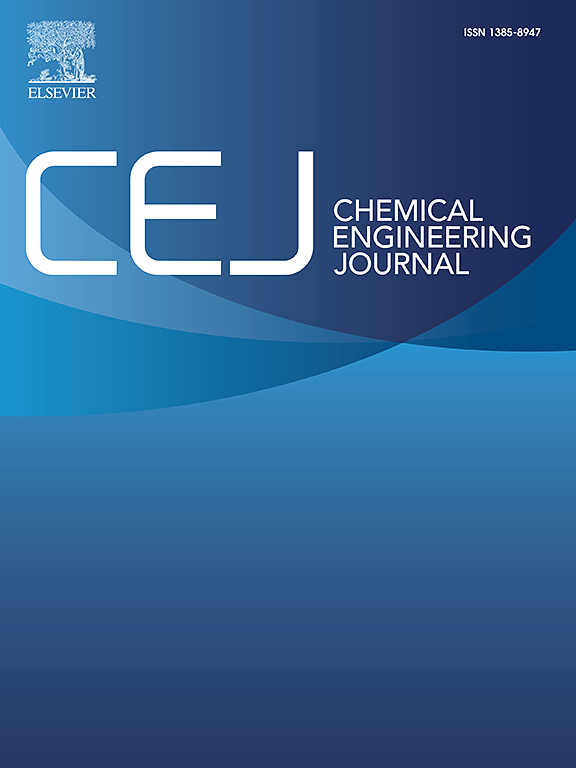Endgroup engineering of the third component for high-efficiency ternary organic solar cells
IF 13.3
1区 工程技术
Q1 ENGINEERING, CHEMICAL
引用次数: 0
Abstract
In this study, we carefully designed and synthesized three A-D-A type molecules, namely YF-C8-CN, YF-C8-S, and YF-C8-O. These molecules feature a 2,2′-bithiophene core, which bears two 2,4,6-tripropylbenzene steric hindrance groups, as the central electron-donating unit, and utilize rhodanine (Rh), thiazolidinedione, and dicyanoyl-modified benzotriazole (BTA) respectively as the electron acceptor unit (A-unit). We investigated their impact as the third component on the performance of ternary organic solar cells (OSCs). Our studies indicate that YF-C8-S, with rhodanine terminal groups, exhibits complementary absorption characteristics and cascaded energy levels when combined with the host binary system (D18:eC9-4F). Compared to YF-C8-CN and YF-C8-O, ternary OSCs based on YF-C8-S demonstrate significantly higher exciton diffusion and charge transport efficiency, favorably impacting the short-circuit current density (JSC) and fill factor (FF) of the OSCs. Furthermore, devices based on YF-C8-S exhibit reduced non-radiative energy loss, contributing to an enhanced open-circuit voltage (VOC). Consequently, ternary OSCs based on YF-C8-S achieve a remarkable efficiency of 19.12%, positioning it among the highest reported values. This comprehensive research on the third component of the YF-C8 series underscores their significant potential for fabricating high-performance ternary OSCs.

高效三元有机太阳能电池第三组份的端组工程设计
在这项研究中,我们精心设计并合成了三种 A-D-A 型分子,即 YF-C8-CN、YF-C8-S 和 YF-C8-O。这些分子以带有两个 2,4,6- 三丙基苯立体阻碍基团的 2,2′-噻吩为核心电子供体单元,并分别利用罗丹宁(Rh)、噻唑烷二酮和双氰酰改性苯并三唑(BTA)作为电子受体单元(A 单元)。我们研究了它们作为第三组分对三元有机太阳能电池(OSC)性能的影响。我们的研究表明,带有罗丹宁末端基团的 YF-C8-S 与宿主二元体系(D18:eC9-4F)结合后,表现出互补吸收特性和级联能级。与 YF-C8-CN 和 YF-C8-O 相比,基于 YF-C8-S 的三元 OSC 具有更高的激子扩散和电荷传输效率,从而对 OSC 的短路电流密度 (JSC) 和填充因子 (FF) 产生了有利影响。此外,基于 YF-C8-S 的器件减少了非辐射能量损失,从而提高了开路电压(VOC)。因此,基于 YF-C8-S 的三元 OSC 实现了 19.12% 的出色效率,跻身所报道的最高值之列。对 YF-C8 系列第三个元件的全面研究凸显了它们在制造高性能三元 OSC 方面的巨大潜力。
本文章由计算机程序翻译,如有差异,请以英文原文为准。
求助全文
约1分钟内获得全文
求助全文
来源期刊

Chemical Engineering Journal
工程技术-工程:化工
CiteScore
21.70
自引率
9.30%
发文量
6781
审稿时长
2.4 months
期刊介绍:
The Chemical Engineering Journal is an international research journal that invites contributions of original and novel fundamental research. It aims to provide an international platform for presenting original fundamental research, interpretative reviews, and discussions on new developments in chemical engineering. The journal welcomes papers that describe novel theory and its practical application, as well as those that demonstrate the transfer of techniques from other disciplines. It also welcomes reports on carefully conducted experimental work that is soundly interpreted. The main focus of the journal is on original and rigorous research results that have broad significance. The Catalysis section within the Chemical Engineering Journal focuses specifically on Experimental and Theoretical studies in the fields of heterogeneous catalysis, molecular catalysis, and biocatalysis. These studies have industrial impact on various sectors such as chemicals, energy, materials, foods, healthcare, and environmental protection.
 求助内容:
求助内容: 应助结果提醒方式:
应助结果提醒方式:


